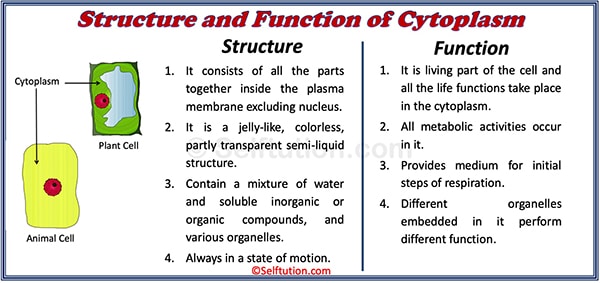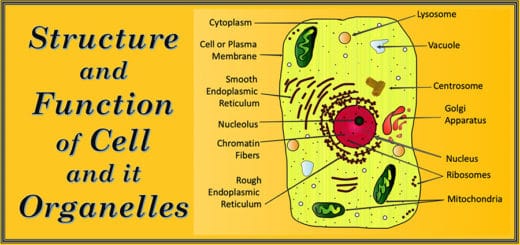Structure of Generalized Cell | Plant and Animal
The Structure of a Generalized Cell helps us understand how all living things function.
Every living organism, whether a plant or an animal, is made up of tiny building blocks called cells.
These cells have different parts, each performing a special job to keep the cell alive and working properly.
Both plant and animal cells share many common structures, such as the cell membrane, cytoplasm, nucleus, mitochondria, and ribosomes.
However, plant cells have some additional parts, like the cell wall and chloroplasts, which help them make their food.
In this blog, we will explore the structure of a generalized cell, its main organelles, and how plant and animal cells differ.
Understanding these differences will help us learn how living things grow, develop, and survive.
For a video explanation…click here
Definition of Generalized Cell
The generalized cell is the basic representation of the cell showing all parts and organelles which can be present in any specialized cell. It is a hypothetical cell for a quick understanding of the basic structure and function of the cell and its organelles.
The structure of generalized cells differs for plants and animals due to the presence or absence of certain parts or organelles. To know more about the difference in the structure of generalized plant and animal cells, click here.

Structure of Generalized Animal Cell

Structure of Generalized Plant Cell
All generalized plants and animal cells consist of living and non-living parts.
STRUCTURE OF THE LIVING PART OF A CELL
The living part of the cell includes the cell or plasma membrane, the cytoplasm, and the nucleus. All three together are known as protoplasm. The non-living parts of the cell are granules and vacuoles.
1. Cell Membrane or Plasma Membrane
The cell membrane is a very thin skin covering the cell. The cell membrane protects the cell and provides shape to it. It is made up of lipoprotein. There are very tiny holes in the cell or plasma membrane. It allows materials to enter and leave the cell through these tiny pores or openings. However, its permeability is selective. It means it allows certain substances to pass through it and prevents others.
The structure and function of a cell or the plasma membrane of a generalized cell are:

Structure and Function of the Cell or Plasma Membrane
Cell Wall: The cell wall is an extra covering that surrounds the cell membrane of a plant cell. It is made of stiff, non-living material called cellulose. The cell wall provides rigidity and protection to the cell. Unlike the cell membrane, it is freely permeable and allows all substances in solution form to pass through it. Animal cells do not have a cell wall.
The structure and function of a cell wall in a generalized plant cell are:

Structure and Function of the Cell Wall in a Generalized Cell
2. Cytoplasm
The cytoplasm is a jellylike, semi-liquid structure occupying most of the inside of the cell. It occupies the space between the cell membrane and the nucleus. Under a microscope, it appears to be colorless, partly transparent, and somewhat watery. It is a living part of the cell, and all the life functions take place in the cytoplasm. The living cytoplasm is always in a state of motion.
The cytoplasm contains many important tiny structures called organelles, which perform various life functions. Organelle means ‘the little organs’. Organelles have a definite structure and a definite function in the cell and have the same status in the generalized cell as the organs have in the body of an animal or a plant. Apart from the nucleus, various other organelles present in the cytoplasm of a generalized cell are the endoplasmic reticulum, Golgi apparatus, mitochondria, ribosomes, lysosomes, centrosome, vacuole, and plastids.
The structure and function of the cytoplasm of a generalized cell are:

Structure and Function of Cytoplasm in an Animal or Plant Cell
3. Nucleus – The Control Center of the Cell
The nucleus is a spherical body present in the cell. This structure is the control center of the cell, and its function is to regulate and coordinate the various life processes of the cell. Most cells have only one nucleus, but some cells, like those of muscles, have more than one nucleus.
The structure and function of the nucleus of a generalized cell are:

Structure and Function of the Nucleus of the Cell
The nucleus comprises four parts – nuclear membrane, nuclear sap or nucleoplasm, nucleolus or nucleoli, and chromatin fibers.
Nuclear membrane – It is the delicate outermost covering layer of the nucleus. It separates the nucleus from the cytoplasm. The nuclear membrane, like the cell membrane, has tiny holes in it that allow the exchange of substances between the nucleus and the cytoplasm.
Nucleoplasm – It is the jellylike fluid inside the nucleus. Chromatin fibers and nucleoli are embedded in the nucleoplasm.
Chromatin fibers – A network of threadlike structures called the chromatin network is present in the nucleoplasm. It consists of DNA (deoxyribonucleic acid) and proteins. At the time of cell division, the chromatin fibers develop into thick and ribbon-like or rod-like structures called chromosomes. These chromosomes play an important role in carrying the genetic characters from the parents to the offspring.
Nucleolus or nucleoli – It is a dense, dark, granular structure without a membrane. It consists of RNA (ribonucleic acid) and proteins. It is the site of ribosome formation, thus, we can call it the factory of ribosomes.
NON LIVING PARTS OF A CELL
a. Granules
Granules are small particles in the cytoplasm that store food particles, such as starch, glycogen, and fats.
b. Vacuoles
Vacuoles are clear spaces in the cytoplasm. They are filled with water and various substances in the solution state. A single membrane called ‘Tonoplast’ bound these bubble-like sacs. In plant cells, the vacuoles are usually quite large, and the liquid that they contain is called cell sap. The cell sap contains proteins, minerals, organic acids, etc. Vacuoles provide turgidity and rigidity to the cell. An animal cell does not have such prominent vacuoles, and vacuoles are also fewer in number.
Structure of generalized plant and animal cells….Selftution








